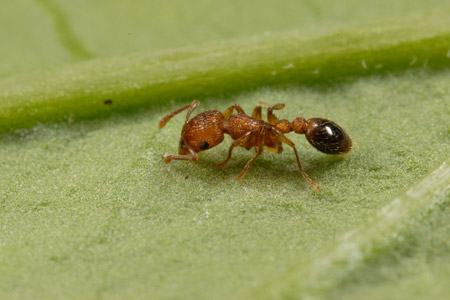Active Seasons




Pavement Ant Appearance and Size Facts
Scientifically known as Tetramorium Caespitum, pavement ants are a common species of ants found in various parts of the United States, including Florida. At around 1/8 to 1/4 inches in length, these small, dark-colored ants are known for their persistent presence in urban and suburban environments. While not aggressive toward humans, pavement ants can become a nuisance by invading homes, gardens, and outdoor spaces. Unfortunately, these ants can also create hygiene concerns by contaminating food and food preparation areas – they’ve crashed a fair share of picnics!
Identifying Pavement Ants From Other Ants
Pavement ants have a two-segmented pedicel (a part of their antennae), which is a distinguishing feature that sets them apart from other ant species. Due to their small size and similar appearance to other ant species, proper identification of pavement ants can be difficult. Fortunately, Florida ant control experts, like those at Hulett, can lend a hand with identification and setting up a treatment plan.
We provide ant control for pavement ants in the following locations and their surrounding areas:

Behavior and Habitat of Pavement Ants
Pavement ants will travel in lines toward food sources on scent trails set by their scouts. They are social insects that live in colonies consisting of multiple worker ants, a queen, and occasionally, winged reproductive individuals. While the colonies tend to be small in size, they can explore considerable distances.
These ants are known for their preference for nesting in soil beneath pavement cracks, sidewalks, driveways, and building foundations. They exhibit both diurnal and nocturnal activity, with foraging ants often seeking food sources in homes and outdoor areas.

Signs of Infestation of Pavement Ants
Common signs of pavement ants include the presence of ant trails along pavement edges and cracks, especially during warmer months. Inside buildings, you might notice these ants foraging near food sources, such as crumbs or spills. Small piles of displaced soil near pavement cracks may also indicate their nesting.

Tips for Prevention of Pavement Ants
Ants, including pavement ants, are highly attracted to the food sources within our homes, so good housekeeping can go a long way in ant prevention. Along with cleaning up crumbs and spills and securely storing foods and sweets, you’ll want to maintain your lawn and keep ant-friendly foliage trimmed away from the sides of your home.
To best prevent ants from entering your space, thoroughly inspect the exterior of your house and seal up any gaps you find. Don’t forget to check window screens and door sweeps throughout the process.
Getting Rid of Pavement Ants
While there are steps you can take on your own to try and eliminate these pests, it’s important to recognize the potential challenges you may face along the way. For instance, identifying the source of the infestation can help you figure out how big of a colony you are dealing with, but getting rid of them requires specialized ant control treatments from an experienced pest control technician.
Effective Pavement Ant Control Solutions
Pavement ants may be small in size, but they can create a large nuisance in and around your home or driveway. Fortunately, our team at Hulett’s Pest Control has the effective pest control measures you need to rid your space of these pesky creatures once and for all.
Our methods are not only designed to be harmless for pets and people, but also proven to be successful in eliminating the source of the infestation, preventing future invasions, and giving you the peace of mind you deserve. From identifying pavement ants to determining the best course of action, our professionals will start the process of reclaiming your pest-free home with your same-day inspection. Hulett is here for you, call today!

